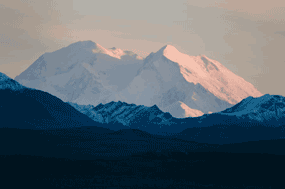 |
| Kent Miller | | Denali with Alpenglow |
 |
Denali, the "High One," is the name Athabascan native people gave the massive peak that crowns the 600-mile-long Alaska Range. Denali is also the name of an immense national park and preserve created from the former Mount McKinley National Park. In 1917 Mount McKinley National Park was established as a game refuge. The park and the massif including North America’s highest peak were named for former senator – later President – William McKinley. In 1980, the Alaska National Interest Lands Conservation Act (ANILCA) enlarged the boundary by 4 million acres and redesignated it as Denali National Park and Preserve. It exemplifies interior Alaska’s character as one of the world’s last great frontiers, its wilderness is largely unspoiled.
More than 650 species of flowering plants as well as many species of mosses, lichens, fungi, algae, and others grace the slopes and valleys of Denali. Only plants adapted to long, cold winters and short growing seasons can survive in this subarctic wilderness. Permafrost ground underlies many areas of the park, where only a thin layer of topsoil is available to support life. After the continental glaciers retreated from most of the park 10,000 to 14,000 years ago, hundreds of years were required to begin building new soils and revegetation. The dynamic glaciated landscape provides large rivers, countless lakes and ponds, and unique landforms which form the foundation of the ecosystems that thrive in Denali.
Denali is well-known for its diversity of wildlife. There are 39 species of mammals, 167 species of birds, 10 species of fish, and one species of amphibian known in Denali. There are no reptiles recorded in Denali. Animal life and activity in Denali is dictated by the seasons. Winter is the longest season and the animals that are year-round residents are well-adapted to life in the subarctic. The brief spring season brings the return of 80% of Denali’s bird life, the waking of hibernating bears, and an increase in activity levels of wildlife. Summer is a time for raising young and preparing for migration, hibernation, or survival during the winter. Summer also brings hordes of insects, including mosquitoes. In late summer king and chum salmon run in the multitude of streams and rivers. In autumn, migrating birds fill the skies and bull moose gather their harems of cows for the mating season.
|






